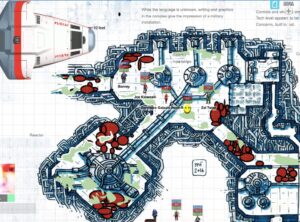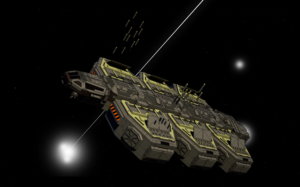IY6026.153
Session starts where we left off. Half the team is investigating the remains of an alien complex they have discovered, and half is on the way in the ship.
In the complex, Flint and Lucky use the drone to scout down the corridors of the complex. They encounter no dangers other than the green slime in various places, and once they get into corridor leading up to the previously discovered control room there is none. Lucky uses the universal translator to try to find out of the green slime is sentient. A smart move. No sign of intelligence of any kind is detected It’s just slime.
 As they explore, Roger, Art, Barney, and Joe are on their way in the ship. Art and Joe pick up another drone heading toward them. Roger makes his Pilot roll, and throws the ship into a corkscrew flight path. As the drone approaches and fires, Barney fires one dual pulse laser turret and Art fires the automated one. They score hits, while the drone misses. Its control computer damaged, the drone flies out of control and is destroyed. They continue toward the complex. Arriving, they see the disabled air-raft. Roger lands the ship, and with the assistance of the mining pod and the robot are able to get the vehicle on board. Barney enters the complex to assist with evaluating it and powering up the alien computers.
As they explore, Roger, Art, Barney, and Joe are on their way in the ship. Art and Joe pick up another drone heading toward them. Roger makes his Pilot roll, and throws the ship into a corkscrew flight path. As the drone approaches and fires, Barney fires one dual pulse laser turret and Art fires the automated one. They score hits, while the drone misses. Its control computer damaged, the drone flies out of control and is destroyed. They continue toward the complex. Arriving, they see the disabled air-raft. Roger lands the ship, and with the assistance of the mining pod and the robot are able to get the vehicle on board. Barney enters the complex to assist with evaluating it and powering up the alien computers.
Roger takes the ship and finds the big cube ship that has landed in the forest nearby. The crew onboard the ship is able to destroy it before it can launch additional drones. The return to the complex site and enter.
Barney evaluates what he sees. It appears to be an engineering and power station. Three vats empty into pipes which disappear down another corridor. He says they are like intended to supply injectants to some kind of reactor.
Inside the control room, the team has had Zal use the universal translator artifact to evaluate the control panels. He’s not an engineer and can’t tell much, but he is able to read the notations of the panels and confirm it is some kind of power regulation system. Barney arrives, and they decide to try to power up the panels. The take the power supply out of the robot, and Barney is able to using his massive Engineering skill to make things work.
While the team works on that project, Flint uses the drone to explore the chamber containing the reactor. Using the multispectral scanners of the drone, he can tell that there is a tiny fissure on the containment vessel and describes if to Barney via radio. Barney says there is probably some kind of spinning core in there, still emitting some radiation, and when it passes that fissure it is creating the signal they picked up that lead them here. The chamber is full of the green slime, and Art deduces the slime must be feeding on the radiation. At this point there isn’t enough radiation to harm the team.
Barney manages to power up the computers, and is able to use the universal translator to gain some info about the installation. He finds that this planet was inhabited by a race called the Drysti, who were descended from avian stock. They attained TL-11, explored space, and attracted the attention of the Enemy. The never saw the Enemy, and lacked the technology to defend themselves. The Enemy destroyed their outposts in the subsector, and finally bombarded this planet with asteroids, scrubbing it. This was a power station on the outskirts of a large military base, which was destroyed by an asteroid strike. While there is no navigation info on the remains of this computer system, they do find some cultural info on the Drysti, which they download for Zal. Barney also finds a stand-down code with which the team can power down the robotic security forces they’ve encountered — still functioning and self-maintaining for many centuries.
The planet now relatively safe, the team returns the ship to the shelter they had previously discovered, and begin pre-jump maintenance.
End Session
IY6026.153
Elapsed game time: 217 days

